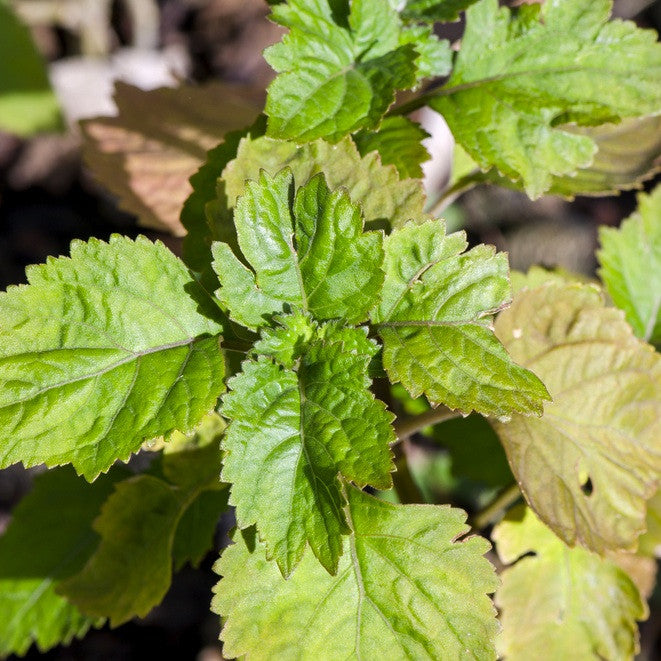TIMELESS Essential Oils
Patchouli, Organic
Couldn't load pickup availability
Pure, Therapeutic Patchouli essential oil, Organically farmed
Product Details
Botanical name
Pogostemon cablin
Extraction method / Source
Steam distillation / Fermented, dried leaves
Aroma
Extremely rich, sweet, earthy, woody
Note classification
Base
Odor Intensity
4
Key constituents
Sesquiterpene hydrocarbons 60 - 65%, Patchouli alcohol 33 - 35%
Plant description
Botanical family: Labiatae or Laminaceae
Patchouli is an aromatic perennial shrub native to the tropical regions of Asia, but now extensively cultivated in many tropical areas of the world. It produces large, fragrant green leaves and small white, pink or purple flowers.
Regions of Production
Indonesia
Growing Practices
Organically farmed. Plants are tested for purity after harvesting.
History / Fun Facts
For centuries, the Patchouli herb has been an important part of traditional systems of medicine in China, Japan and Malaysia. It is used to treat colds, headaches, nausea, vomiting, diarrhea, and abdominal pain. It has also been used extensively in Asia as a deodorant and insect repellent. An effective moth repellent, dried Patchouli leaves were packed with Oriental rugs being transported by ship for trade with the West in the 19th Century, and gave the rugs a characteristic exotic odor.
Properties
Antidepressant, anti-inflammatory, antiphlogistic, antiseptic, aphrodisiac, astringent, cicatrisant, cytophylactic, deodorant, diuretic, fever-reducing, fungicide, insecticide, regenerative, sedative.
Please refer to the Glossary for terms which may be new to you.
Uses / Benefits
Beneficial in treating sores and skin fissures and inflammation, scars, fungal and parasitic skin conditions, eczema. Helps alleviate depression, anxiety and stress related conditions. Patchouli's alluring scent makes it a popular fragrance for both men and women. (Also see our Patchouli Ittars in the Natural Perfumes and Ittars section.) Used in the fragrance industry as a fixative for fragrances. Patchouli is an effective moth repellent.
Patchouli essential oil gets better with age, if stored in an airtight container away from heat and light.
Fragrant influences
Harmonizing and stabilizing effect on the mind, promotes concentration and focus. Recommended for "dreamers" and those who tend to feel detached from their bodies. Encourages communication and reasonableness. Also used as an aphrodisiac.
Modes of Administration
Topical: massage, compress, bath, skin care
Inhalation: direct inhalation, diffuser, oil vaporizer.
Blends well with
Bergamot, Black Pepper, Cinnamon, Clove, Coriander, Frankincense, Geranium, Ginger, Grapefruit, Jasmine, Lemongrass, Litsea Cubeba, Mandarin, Neroli, Orange, Rose, Sandalwood, Ylang Ylang
Safety
Non-toxic, non-sensitizing, non-irritating.
Notice
This information is for educational purposes only. It has not been evaluated by the US Food and Drug Administration. It is not intended to diagnose, treat, cure or prevent any condition or disease. Although we strive to provide information which is accurate and up to date, we cannot guarantee the accuracy or completeness of this information.
Precautions
Pure essential oils are highly concentrated plant extracts. Do not use them undiluted, or in the eyes or mucus membranes. If applying an essential oil to the skin, always dilute it with a proper carrier oil and test on a small patch of skin before applying to a large area. Do not take them internally except under the direction of a qualified professional trained in Aromatherapy. Always familiarize yourself with the safety, contraindications and proper preparation of each essential oil before use. Note that when using essential oils for children and the elderly, very low concentrations should be used. Keep all essential oils away from children and pets.
References
Aftel, Mandy, Essence & Alchemy, A Natural History of Perfume, 2001. North Point Press, New York, NY.
Battaglia, Salvatore, The Complete Guide to Aromatherapy, Second Edition, 2003. The International Centre of Holistic Aromatherapy, Brisbane, Australia
Cooksley, Valerie Gennari, Aromatherapy: Soothing Remedies to Restore, Rejuvenate, and Heal, 2002. Prentice Hall Press, New York, NY.
Cooksley, Valerie Gennari, Aromatherapy: A Holistic Guide to Natural Healing with Essential Oils, 2015. Floramed Publishing, The Woodlands, TX.
Fitzsimmons, Judith and Bousquet, Paula M., Seasons of Aromatherapy, Hundreds of Restorative Recipes and Sensory Suggestions, 1998. Conari Press, Berkley, CA.
Green, Mindy, Natural Perfumes, 1999. Interweave Press, Loveland, CO.
International Fragrance Research Association, http://www.ifraorg.org/en-us/standards (January 5, 2016)
Mojay, Gabriel, Aromatherapy for Healing the Spirit, 1997. Healing Arts Press, Rochester, VT.
Shutes, Jade, The Dynamics of Blending: A Guide to Blending and a Reference Manual for Essential Oils and Base Materials, 2014. The East-West School for Herbal and Aromatic Studies, Chapel Hill, NC.
Tisserand, Robert and Young, Rodney, Essential Oil Safety, 2nd edition, 2014. Churchill Livingstone Elsevier, New York, NY.
United States Food and Drug Administration, HHS, 182.1 Substances That Are Generally Recognized as Safe, 182.20 Essential oils, Oleoresins (solvent-free), and natural extractives (including distillates), http://www.gpo.gov/fdsys/CFR-2012-title21-vol3-sec182 (January 28, 2016)
TIMELESS Essential Oils guarantees the purity and quality of all our therapeutic oils. The current Certificate of Analysis is available upon request. All essential oils are best stored in an airtight container away from heat and light.




